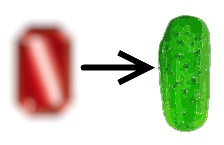From Ruby to Gherkin: Building Automated System Tests, pt 2
May 29, 2013

Follow-up to Building a Test Script Environment with C# and IronRuby, pt 1, wherein we change emphasis from coding tests in Ruby to writing them in English (Gherkin) with the help of SpecFlow.
After that October post, I managed to construct a full system/regression test suite for a key data-management application, using the combination of Ruby and C# as described. My team has been able to go through several cycles of…
- Updating unit tests to reflect change requests,
- Writing code to pass the tests, and
- Getting swift regression test results back from the system test process acting on the fully-integrated code, and finally
- Running a new test file that exercises the enhancement.
Oops, there is something amiss with that: the new test file should have been added to the system automation test suite at the outset, not at the end. That is, "test-first" should have applied at the system level, in addition to the unit level. But that's not the point of this article. The point is this: at the end, I did not have a product that a business user could easily review and correct.
Arguably, a non-programmer could read the code more easily, thanks to the use of Domain Specific Language concepts. Nevertheless, there was a lot of setup code that obscured intent, and the tests frankly still looked daunting to a non-programmer. Compounding the difficulty is the fact that the non-programmer users are still trying to understand the fundamentals of software testing, in plain English, and without the benefit of meaningful time to study. In other words, asking someone else to verify and maintain these tests would be throwing them into the deep end with inadequate support. The inspect-and-adapt mentality suggests modifying the system testing approach.
Inspect-and-adapt:
- Tests are still too hard to read, and
- The learning curve was too high,
- Therefore find a simpler product.
Gherkin to the rescue! The Gherkin language provides a very simple format for writing tests in plain English. A programmer then writes code that executes the intended actions, in the context of an automation system. Initially I continued on the Ruby path by trying to install RSpec as the interpreter, but I could not get it to install properly in IronRuby. Undismayed, I revised my goal: no longer would I seek to convert a tester into a Ruby programmer. Instead, I would encourage that tester to write and review English-language test scenarios in Gherkin, which the programming team would then support with code in C# using the SpecFlow framework.
At that point, we were working on a line-of-business application. Whereas learning the rudiments of Ruby, and setting up the code environment, had taken a good deal of effort, I was up-and-running with meaningful tests in SpecFlow within a day. More importantly, the other members of my team were immediately able to utilize and even correct small mistakes in these test scenarios. The learning curve was negligible when presented with a working example. And at long last, we were able to present a file containing test descriptions to a business analyst and get direct feedback.
The IronRuby experiment was not a failure: it delivered a meaningful result. Empirically, however, it was a less-than-satisfying result. We evaluated, re-prioritized, and moved-on to the next iteration of our experimentation: SpecFlow. Now we feel that we have the foundation for real organizational growth around software testing.
No TrackBacks
TrackBack URL: http://www.safnet.com/fcgi-bin/mt/mt-tb.cgi/106
Leave a comment